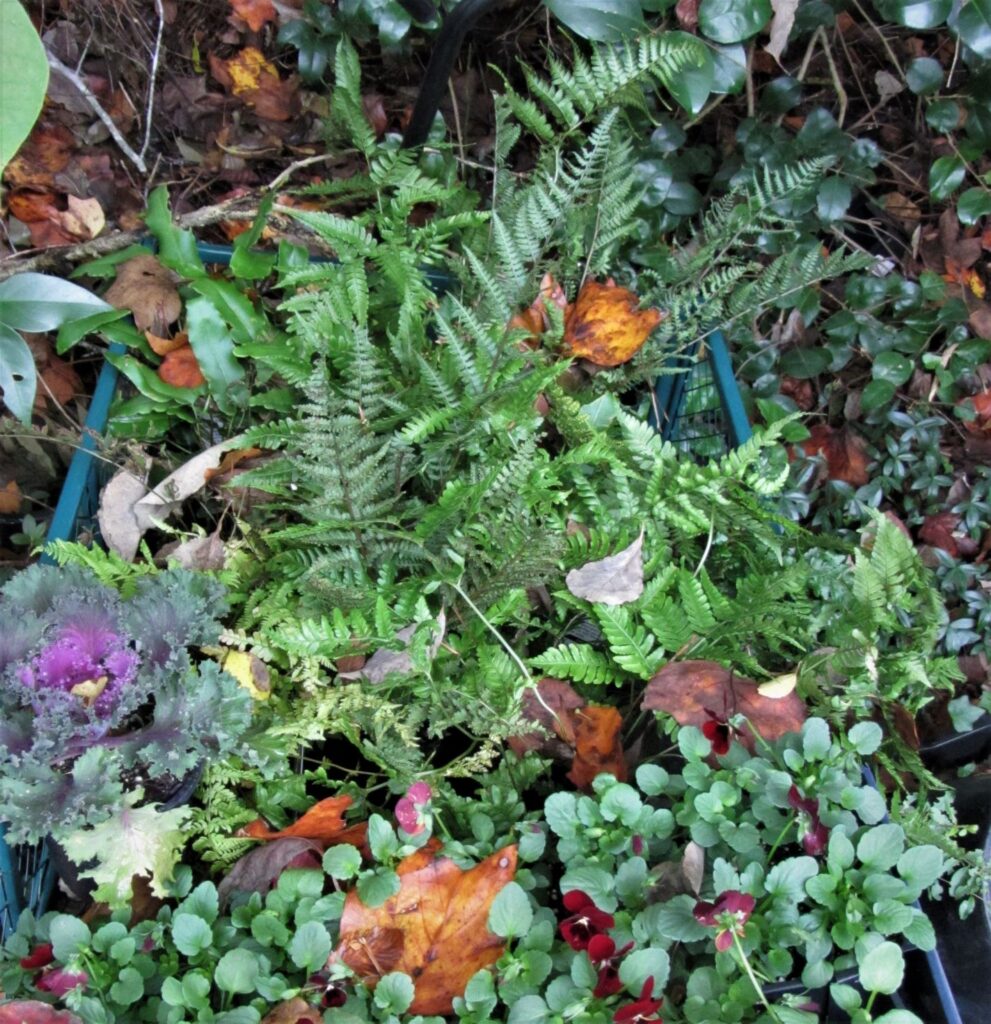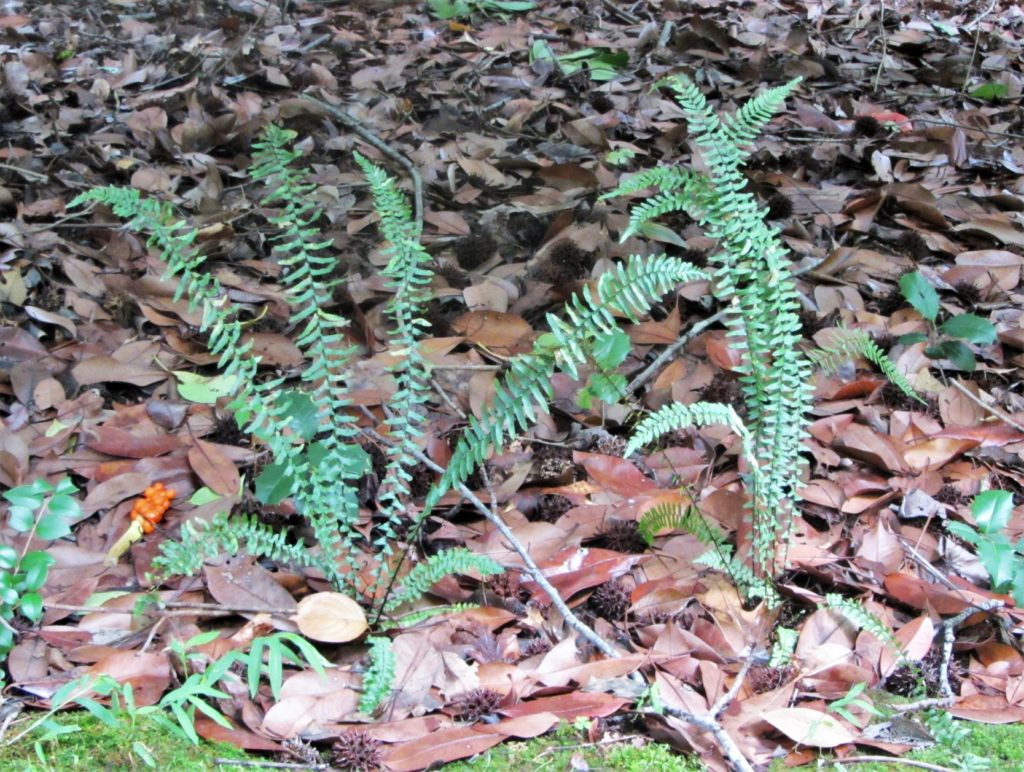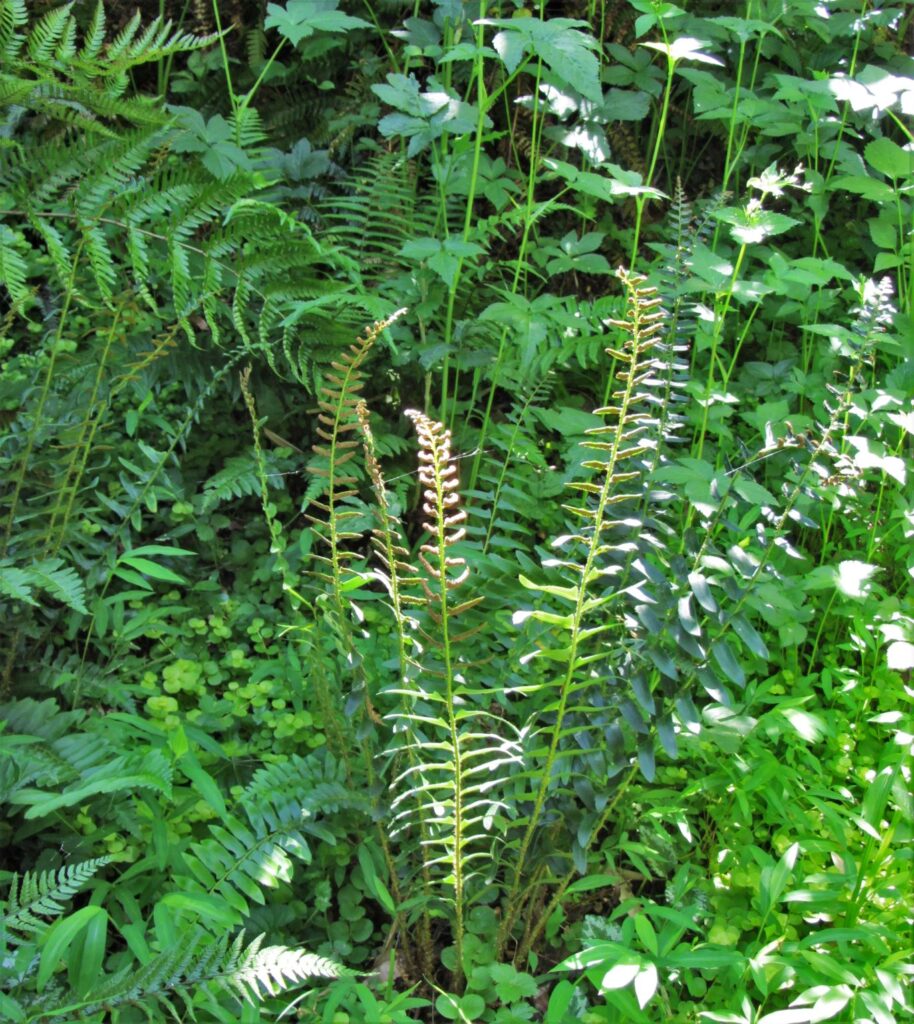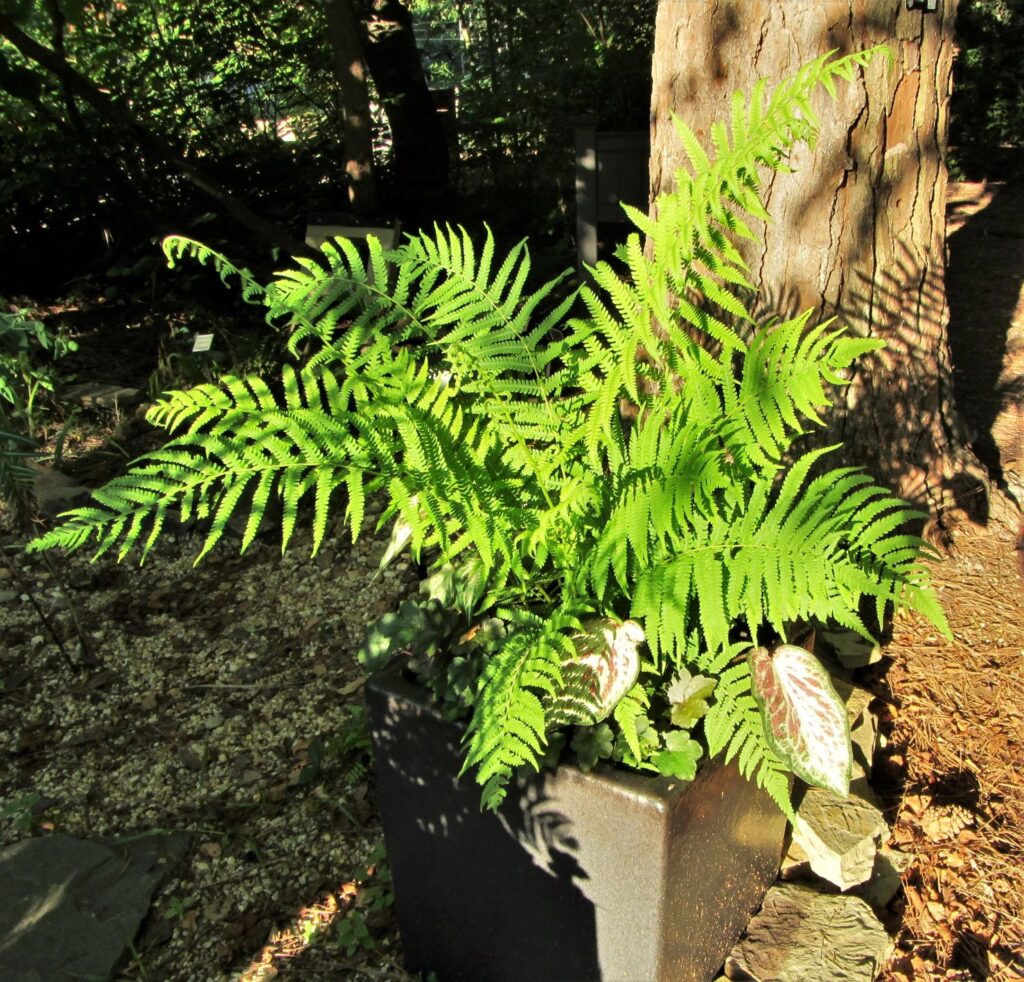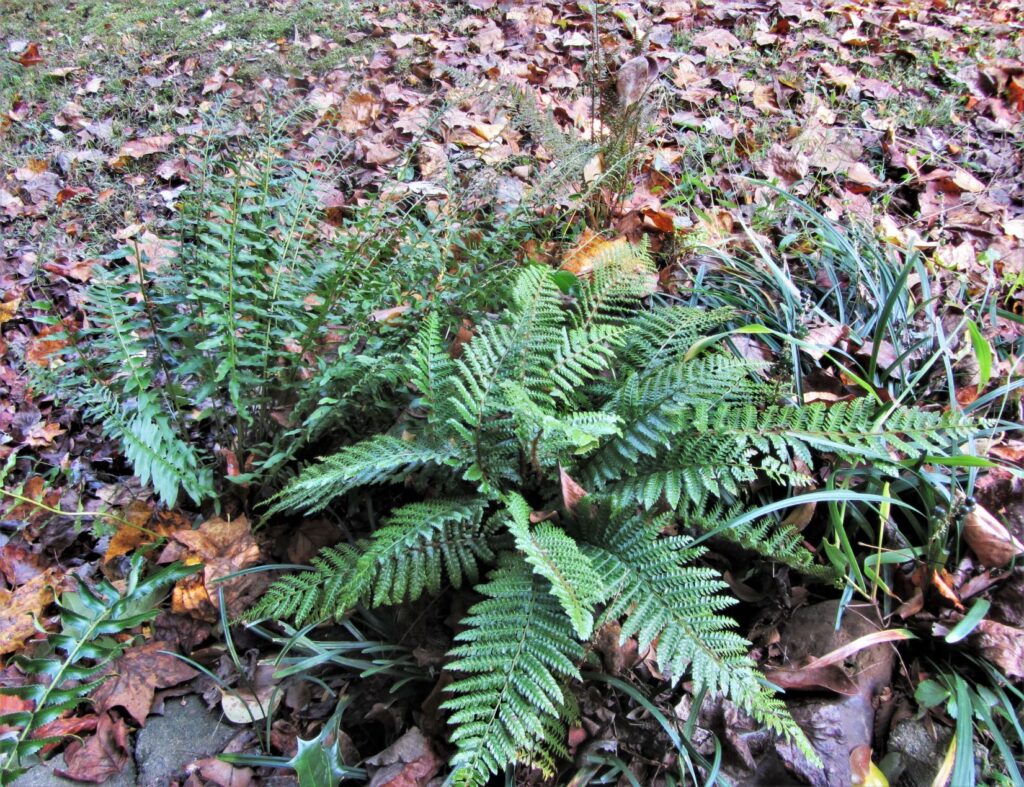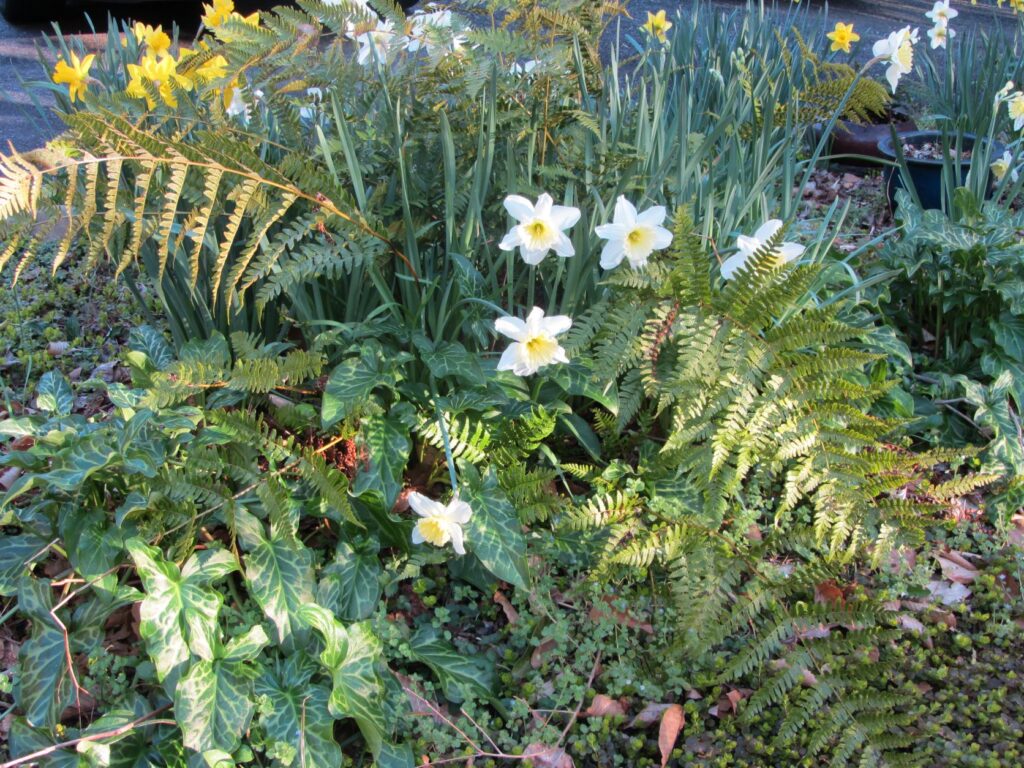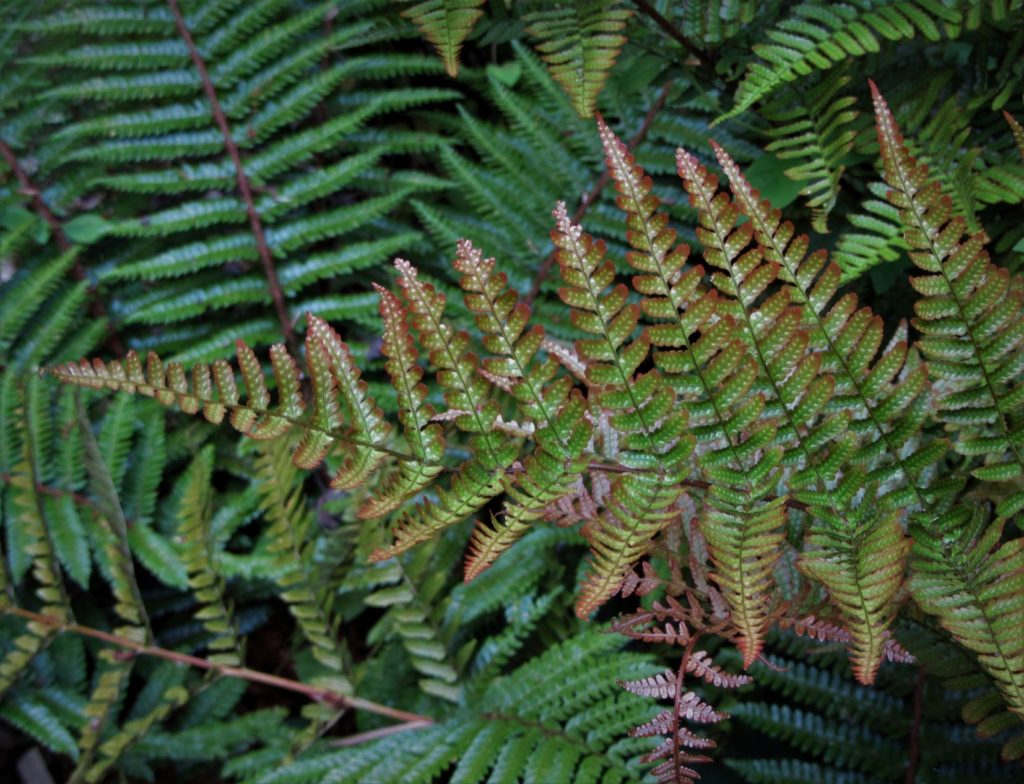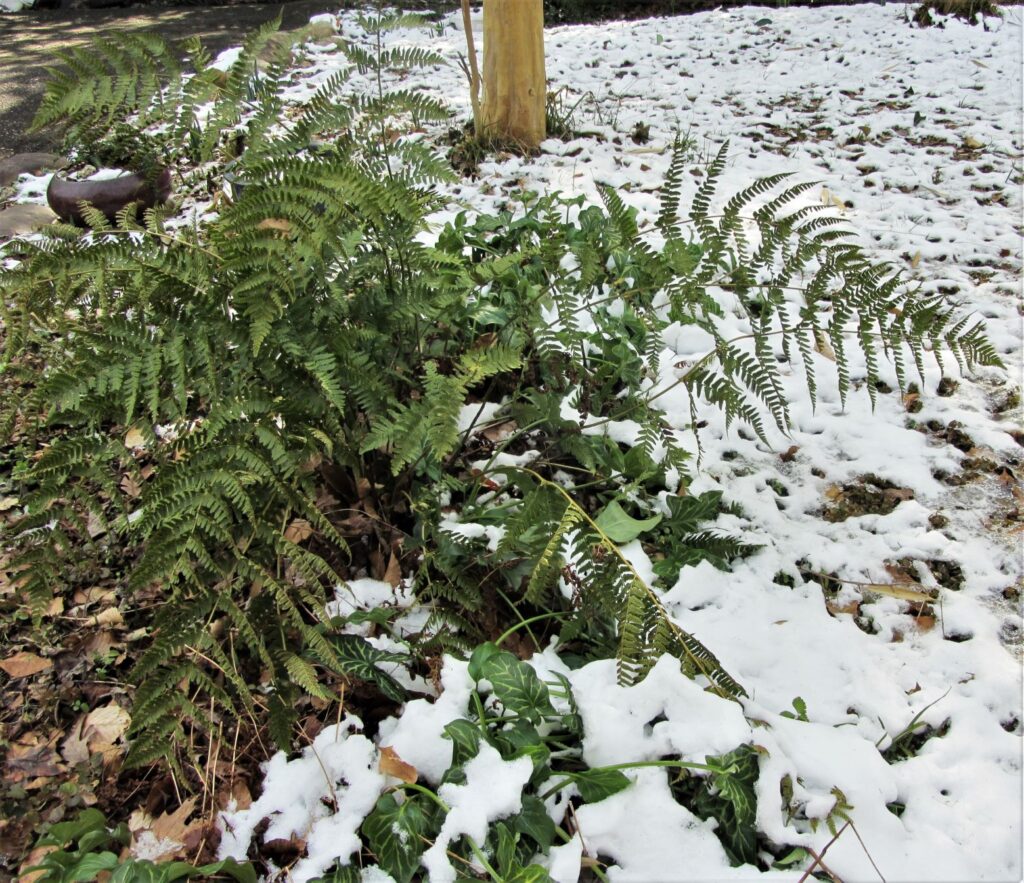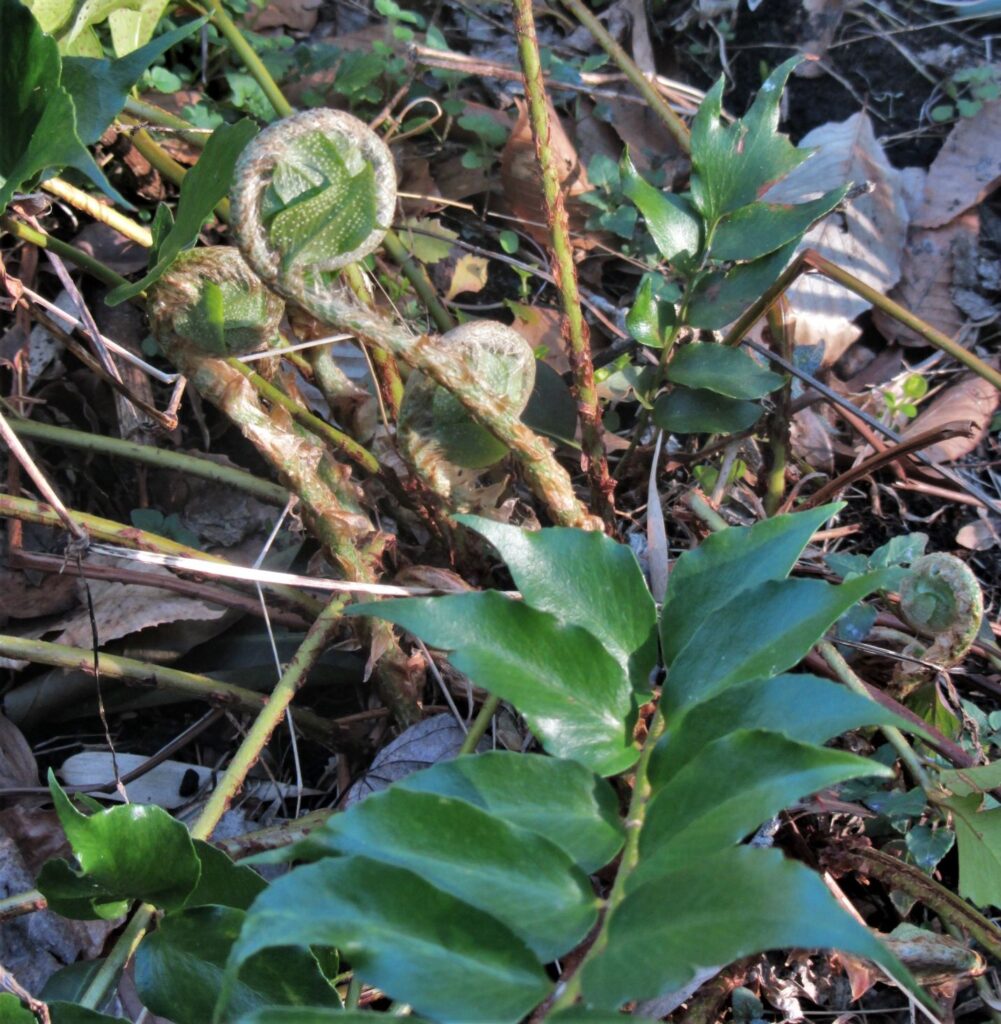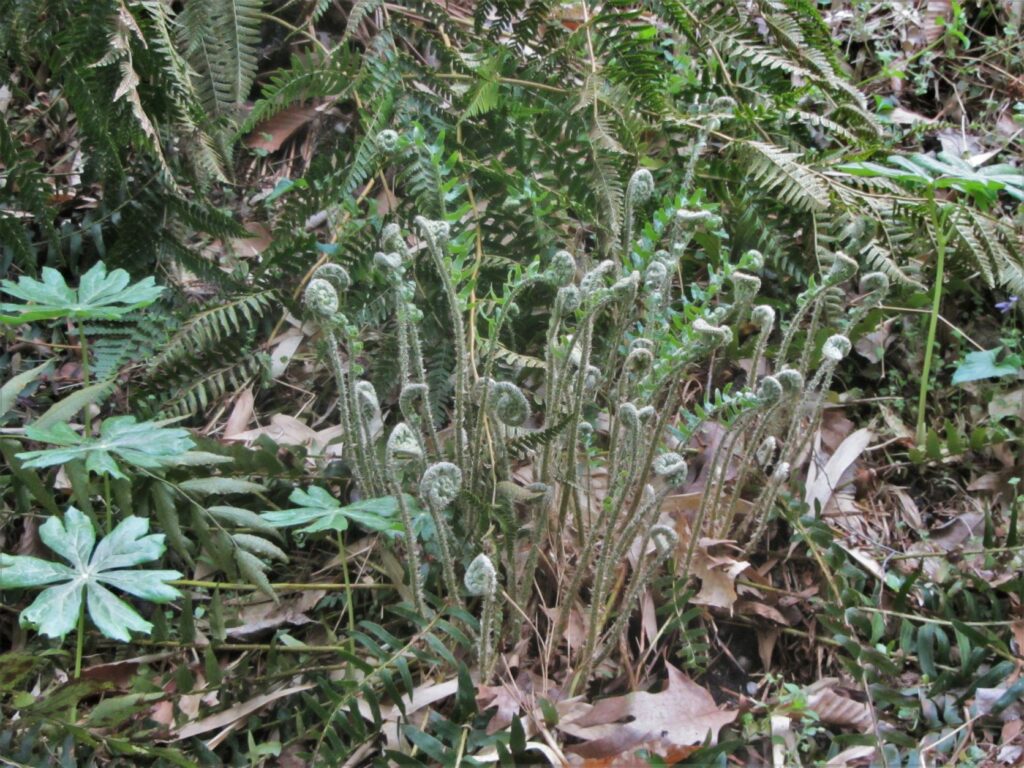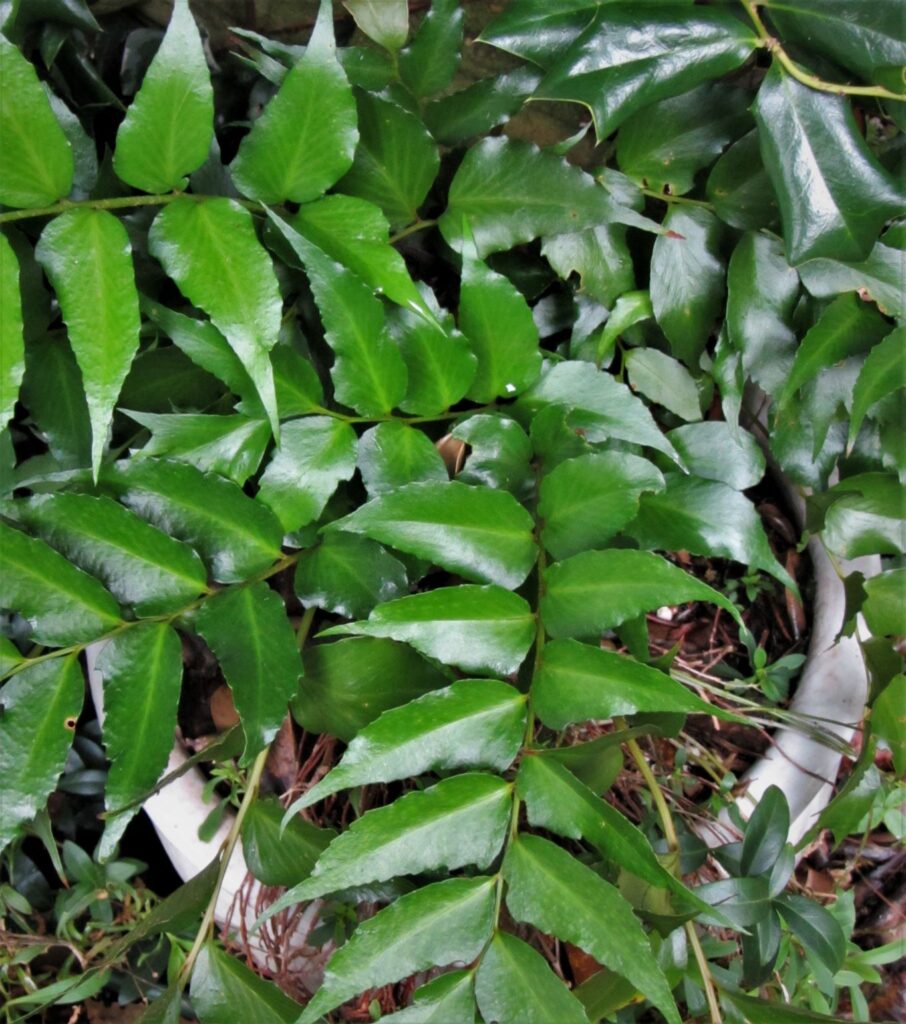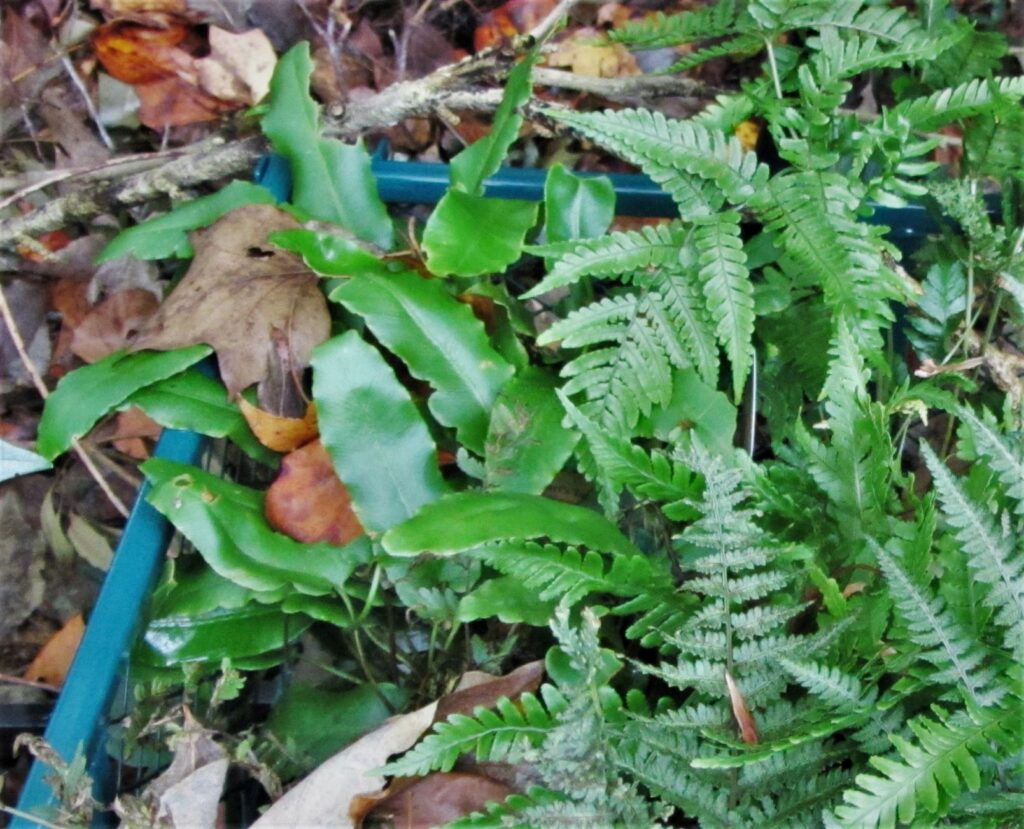Evergreen Ferns Brighten Winter Gardens
Autumn color and falling leaves turn a gardener’s thoughts to the winter months ahead. While we’re still buying flats of bright pansies, pots of chrysanthemums and a pumpkin or two, let’s take the opportunity to also seek out evergreen ferns at local garden centers and online nurseries. Evergreen ferns brighten the winter landscape as the ‘main event’ in winter container plantings, as ground cover under trees, and in borders and foundation plantings.
There are at least four genera of evergreen ferns that perform well in our area. Three of them include East Coast native ferns: the Christmas fern, Polystichum acrostichoides, ebony spleenwort, Asplenium platyneuron, and Dryopteris ludoviciana, the southern shield fern. You will commonly find these growing in nearby woods and may have them in your yard, already. They will remain green and fairly upright through at least the first part of the winter.
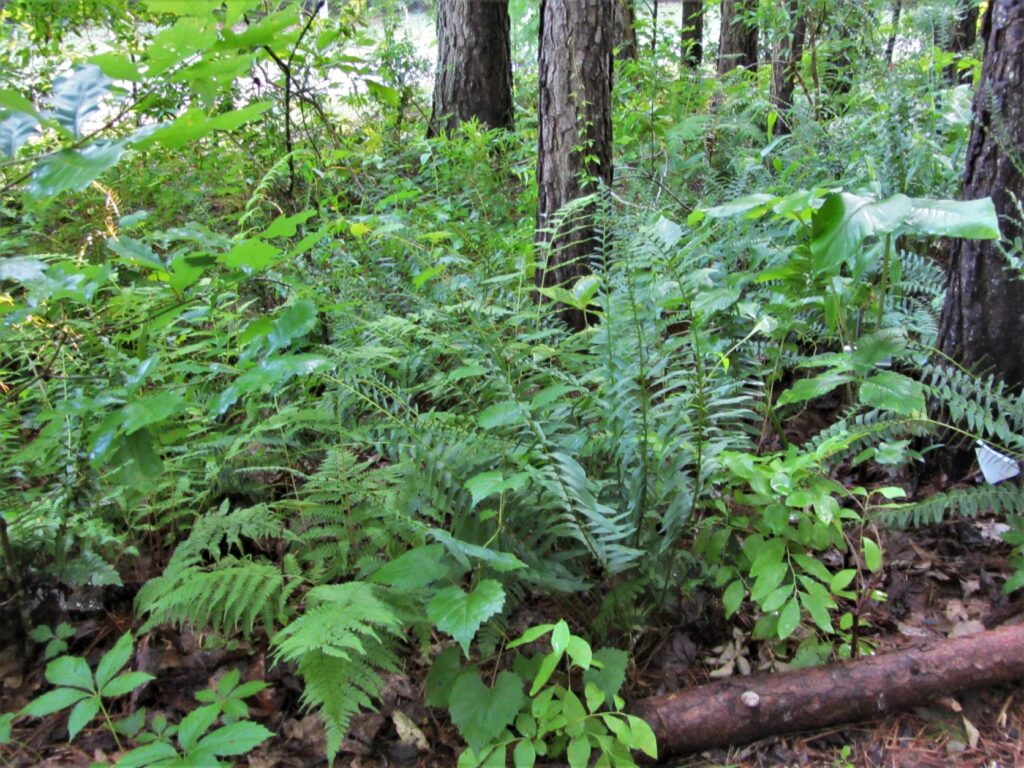
Christmas fern, center, grows among other ferns and perennials at the Williamsburg Botanical Garden and Freedom Park Arboretum.
Christmas fern has once-pinnate fronds of dark, blue green and grows to 2’-3’ tall in Zones 3-9. It has silver, hairy scales on its fiddleheads and stipes. By late summer, narrower, fertile pinnae develop near the top of each frond. This is a simple, classic fern that forms a vase shaped clump that slowly expands over the years. It is drought tolerant and prefers well-drained soil.
Ebony spleenwort is a smaller, more fragile appearing version of the Christmas fern. Its fronds are also simple but grow narrower, more upright, and shorter than a Christmas fern. There are generally only a few fronds at a time in each clump. Hardy to Zones 3-9, ebony spleenwort also needs well-drained, neutral to sweet soil soil, and can even grow on walls and between rocks. Feature this fern in a container, or in the foreground of a shady bed.
The southern shield fern enjoys a wetter site than these other evergreen ferns and is a tall, lush plant with lighter green bi-pinnate fronds. It can grow 3’-4’ tall and wide. It is most common in the coastal Southeastern United States in Zones 6-10. Use this fern in a rain garden or wet spot. It prefers neutral to acidic soil and will grow on clay or loam, and can tolerate sandy soil.
These indigenous ferns are perfectly suited to our climate and largely care for themselves, once planted. Christmas ferns and ebony spleenwort are both good choices for dry shade under trees. Christmas ferns may be used as foundation plantings on the shady side of your home. While fronds of these ferns may fall over under the weight of ice and snow, new fiddleheads will emerge by late winter.

Polystichums have hair like scales on their fiddleheads and rachises that birds gather to line their nests. Korean tassel fern
There are several other types of hardy evergreen ferns, not native in coastal Virginia, that will hold their color and presence even after new fronds emerge next spring. They are all easy to locate in area garden centers.
A beautiful evergreen fern related to our native Christmas fern is the Korean tassel fern, Polystichum polyblepharum. It has distinctive silvery scales that cover its fiddleheads and stipes, which makes it look furry. You might want to reach out and stroke it. The tassel fern is deep green and a bit shiny, with a silvery brown rachis. Birds gather scales from Polystichums to line their nests, and small animals find shelter under their fronds.
This is one of the more interesting ferns to watch as its new fronds unfold, and it has tremendous presence and character. Although newly purchased plants can live in a hanging basket or 8”-12” pot, this fern eventually matures to stand about 3’ tall and nearly as wide. Its rhizome forms a ‘trunk’ over time. It grows wider with longer fronds as the fern ages, but it won’t send out runners. This fern has a more prostrate habit when young, and its fronds always reach out sideways as they arch. It looks wonderful elevated in an urn or basket.
Tassel fern is imported from Japan, Korea and China where it is considered common. It first came to the United States more than 50 years ago and it has won praise and distinction for its beauty. Its cut fronds are used by florists. It isn’t drought tolerant, however, and the fronds will brown and crisp if it dries out or gets too much sun. Give it plenty of root space in a pot, and plant it in moist, fertile soil in the shade. It is hardy in Zones 6-9.
Another favorite evergreen fern with North American relatives is the wood fern, Dryopteris erythrosora ‘Brilliance.’ You may already be familiar with this beautiful fern. It was one of the first ‘colorful’ ferns when it was introduced more than a decade ago. New fronds emerge copper, and slowly settle into a shiny, medium green after several weeks of growth. New fronds emerge regularly from March through autumn. The effect is magical, as many different colors and shades of copper and green mingle on a single plant. Like these other wood ferns, the fronds are sturdy, bipinnate and very graceful.
When autumn slips into winter, the long fronds of D. ‘Brilliance’ hold up well to freezing nights, snow, and ice. Brilliant green fronds peak out through melting snow, and the plants remain mostly upright well into the following spring. When fronds begin to fade, simply cut them away. Otherwise, they form a mat around the plant to protect and mulch the soil.
‘Brilliance’ grow to 3’-4’ tall after several years, forming an ever-thickening clump of fronds. They don’t ‘run’ or send up new clumps nearby. Once established, they prove drought tolerant and take some sun. Grow them on clay, loam, or in a pot with potting mix. Water new plantings during dry spells for the first year or so. As their roots develop, they soon take care of themselves.
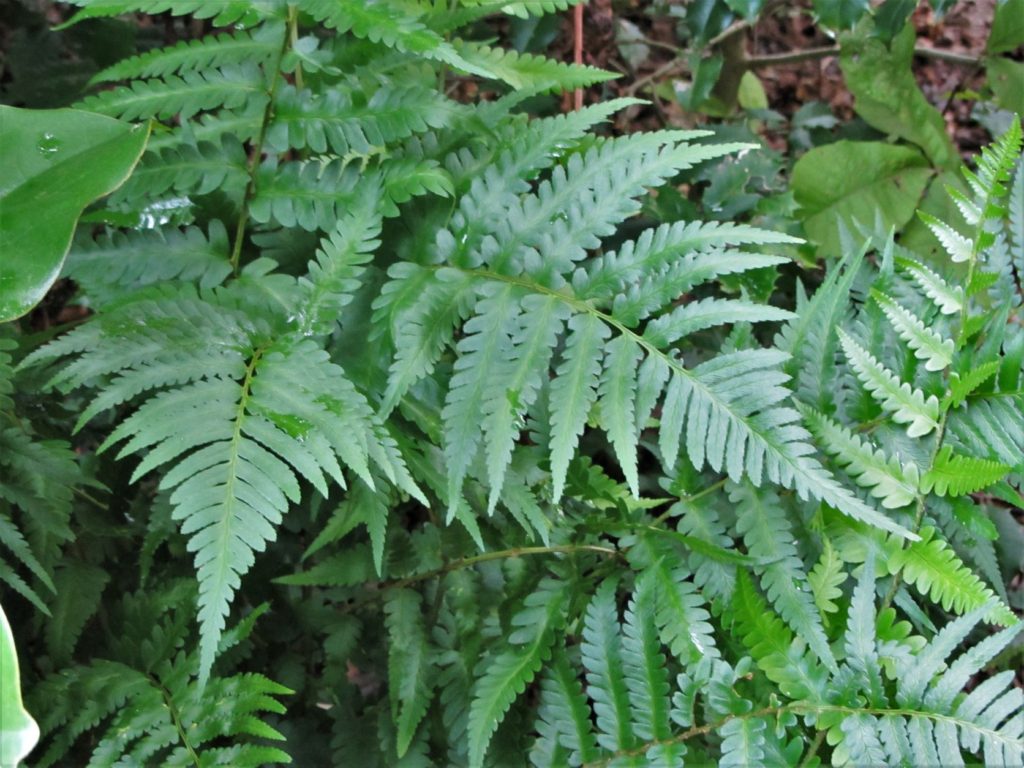
Dryopteris x australis is a natural hybrid of two native wood ferns. It grows to 5′ tall and remains green late into winter.
The closest native species, Dryopteris x. australis, D. ludoviciana and D. celsa, will hold their color and form for a few months more, but may not go the distance until March. They have a similar form, grow perhaps a foot or two taller, but don’t have the bronze or golden color on their new fronds. Of the three, D. ludoviciana, the Southern shield fern, may be found locally at times.
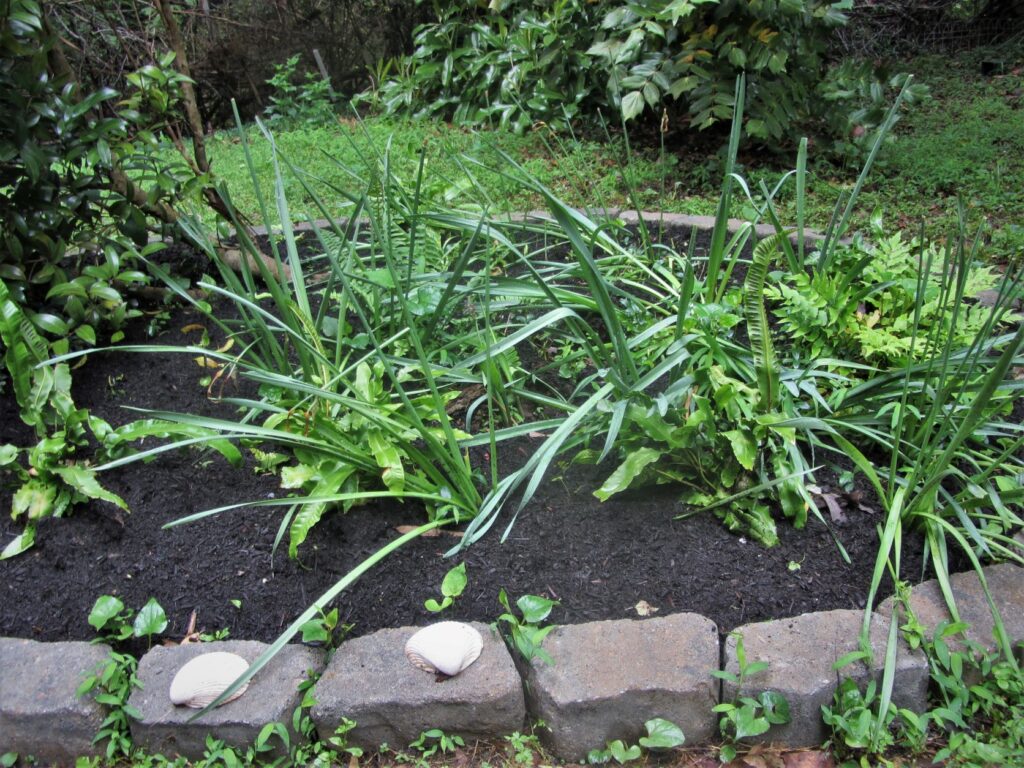
Hart’s tongue ferns need a shadier spot than they found in this newly planted bed. They grow yellow and stunted in too much sunlight. Concrete blocks used in making the planting area help provide the sweeter soil they prefer.
Asplenium scolopendrium, or hart’s tongue fern, is found on several continents, including North America. Technically, A. scolopendrium var. americanum is native to the Eastern United States in a very few areas, and is considered endangered. The European variety is available commercially and grows best in sweet to neutral soil in part to full shade. Hardy in Zones 5-9, this odd-looking, clumping fern is evergreen. Fronds are upright and undivided. Several cultivars have crested or otherwise decorative fronds. Aspleniums frequently grow on old masonry and stone walls. Consider building a raised bed from concrete landscaping blocks in the shade of mature trees to grow this Asplenium well.
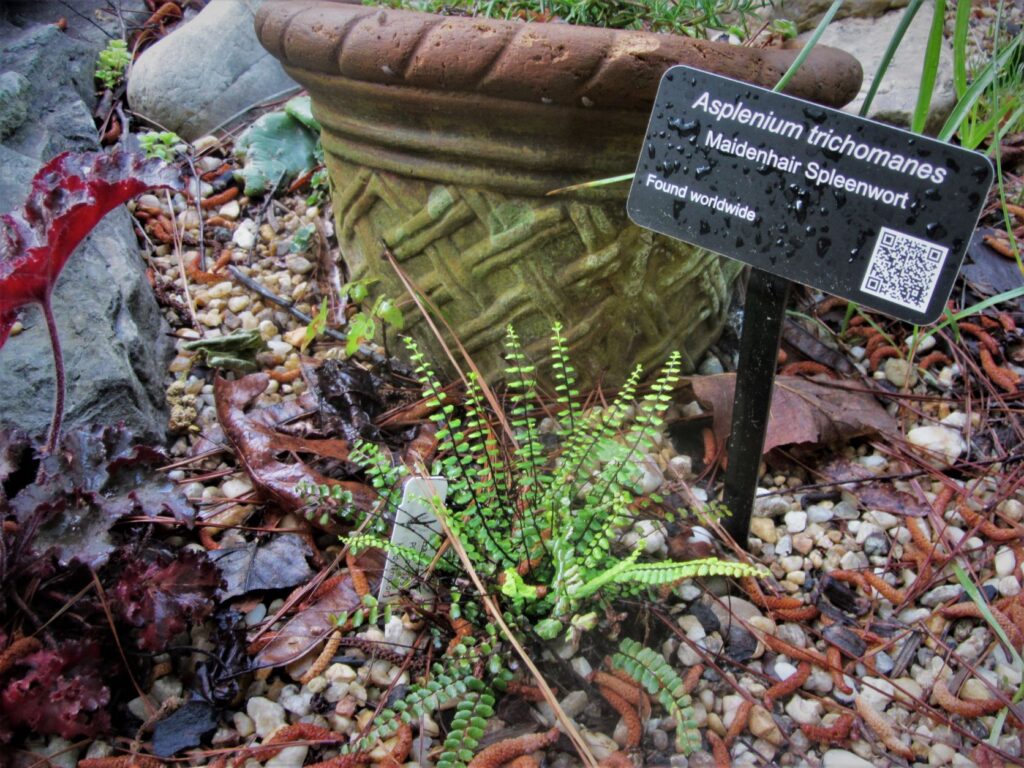
Maidenhair spleenwort remains very small, but is one of the toughest ferns. This A. trichomanes was raised by the Hardy Fern Foundation and offered on a member’s only sale.
Other types of evergreen ferns are the Japanese holly fern, Cyrtomium falcatum, Zones 7-10 and Cyrtomium fortunei, Fortune’s holly fern, Zones 5-10. Use these interchangeably, depending on what is available. I prefer C. falcatum for its glossier, more substantial pinnae. This is another large, bold foliage fern. It emerges deep green and remains that way through all types of weather. Some fronds may turn dark by early spring, but new fronds are already emerging by then and you simply cut away old fronds as they look tatty.
This erect fern forms a vase shaped rosette of once-pinnate leathery fronds. Each broad pinna is toothed and beautifully shaped, and each frond reminds me of a branch of Oregon grape holly. Japanese holly fern grows beautifully in full shade. Grow in potting mix or in whatever soil happens to fill your garden. Once established, it is reliably drought tolerant.
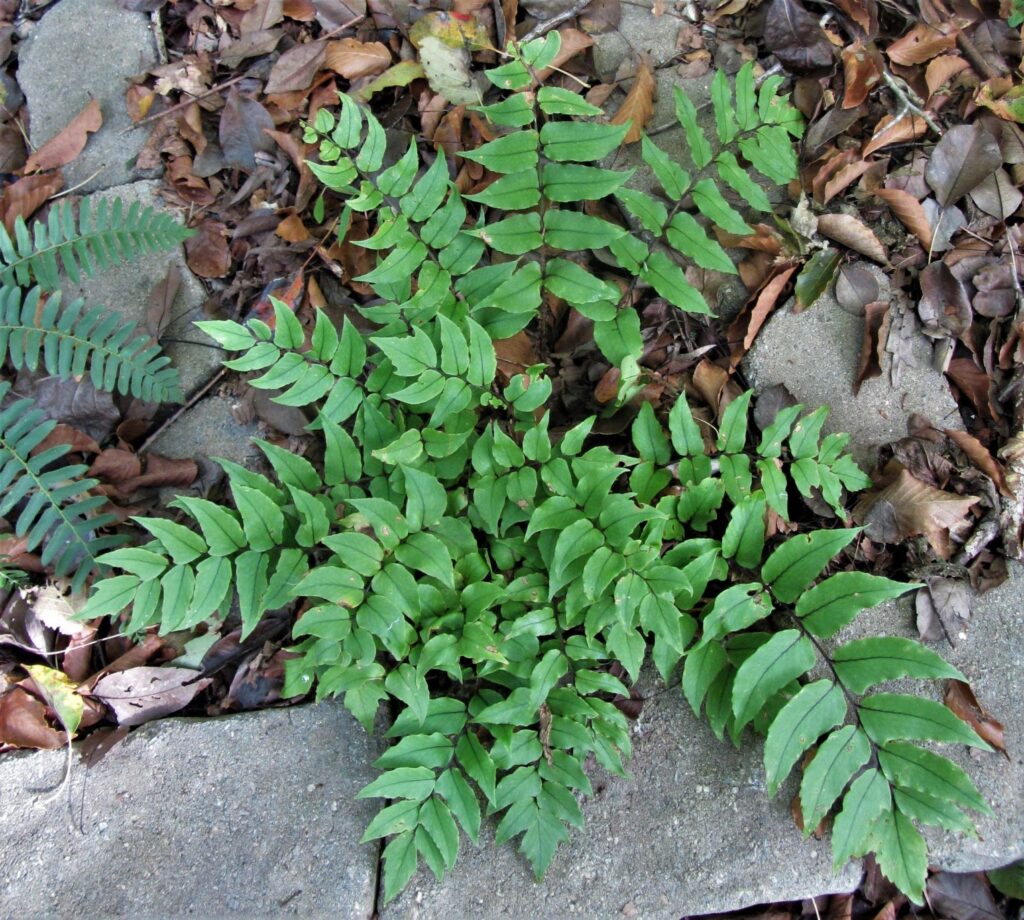
C. fortunei, Fortune’s holly fern, grows beside a Christmas fern on a shady bank to help control storm water erosion.
Fortune’s holly fern has a softer look with smaller, lighter colored pinna. It isn’t as leathery but has a beautifully dark rachis to contrast with the soft pinnae. Holly fern resembles our Christmas fern in form, and it grow to about 30” tall. In its native Japan, Korea, China, Vietnam and Thailand it is a forest fern, but grows well in a variety of habitats.
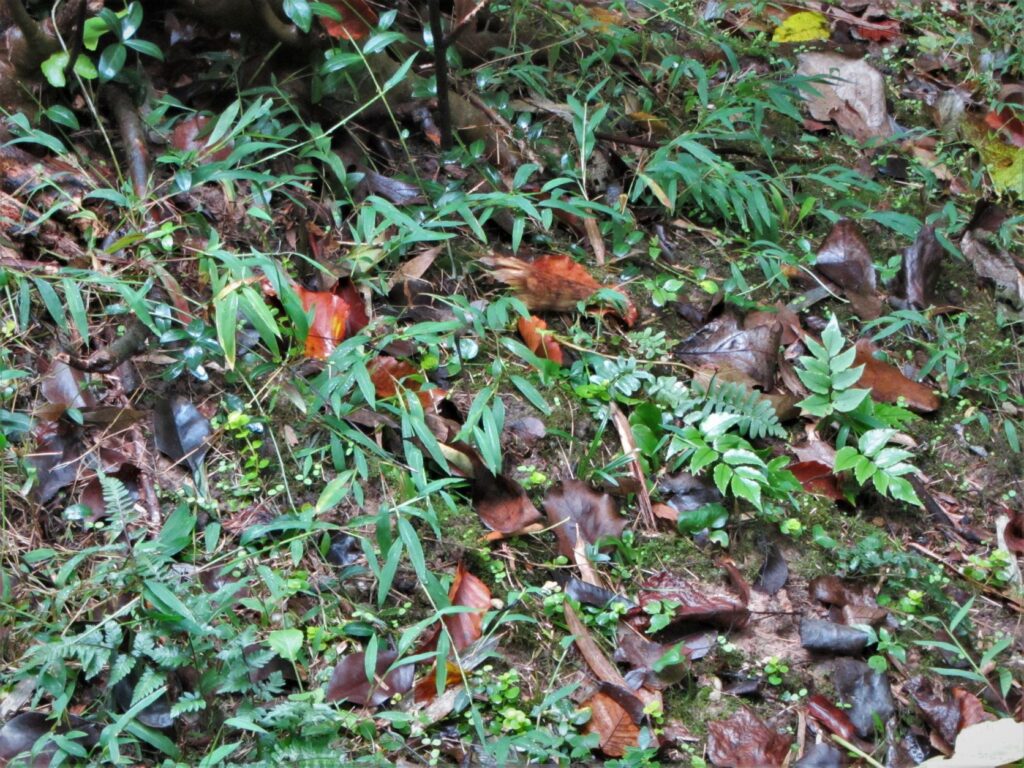
Volunteer ferns crop up in the moss in shady areas of our back garden. They have shallow roots and are easy to transplant.
Both holly ferns may naturalize. I have found several sporelings growing out of patches of moss in my garden this year, which I’ve scooped up and transplanted. Holly ferns aren’t invasive, don’t spread on rhizomes, and simply delight as good landscape plants year after year.
Plant any of these evergreen ferns into a seasonal container arrangement with winter blooming annuals or other evergreen perennials, or directly into a prepared planting bed in full shade to partial sun. Most of them appreciate neutral to acidic soil with lots of organic matter, and all will grow in potting mix out of the bag. After a few years in a pot, give these ferns a permanent spot in your landscape. I like them as ‘shoes and socks’ under shrubs, on slopes, and planted in masses to divide areas of the garden.
Ferns often grow best on slopes where they have excellent drainage. Once established, they need very little care. Cut away old fronds once they look ragged, if you want, but the ferns don’t require any trimming back, fertilizing, or pest control. Ferns filter and clean the air as they sequester carbon, manage storm water run-off, and offer cover to birds and other small animals.
Deer and rabbits rarely graze on ferns, so you can plant them with confidence. They are refined enough to keep even the fussiest HOAs happy. You will find some of these evergreen ferns growing in containers, in the woods, and around the rock garden when you visit the Williamsburg Botanical Garden this fall.
Reliably Evergreen Ferns that can be Sourced Locally:
Asplenium platyneuron (native)
Asplenium scolopendrium
Cyrtomium falcatum
Cyrtomium fortunei
Dryopteris erythrosora ‘Brilliance’
Dryopteris ludoviciana (native)
Polystichum acrostichoides (native)
Polystichum polyblepharum
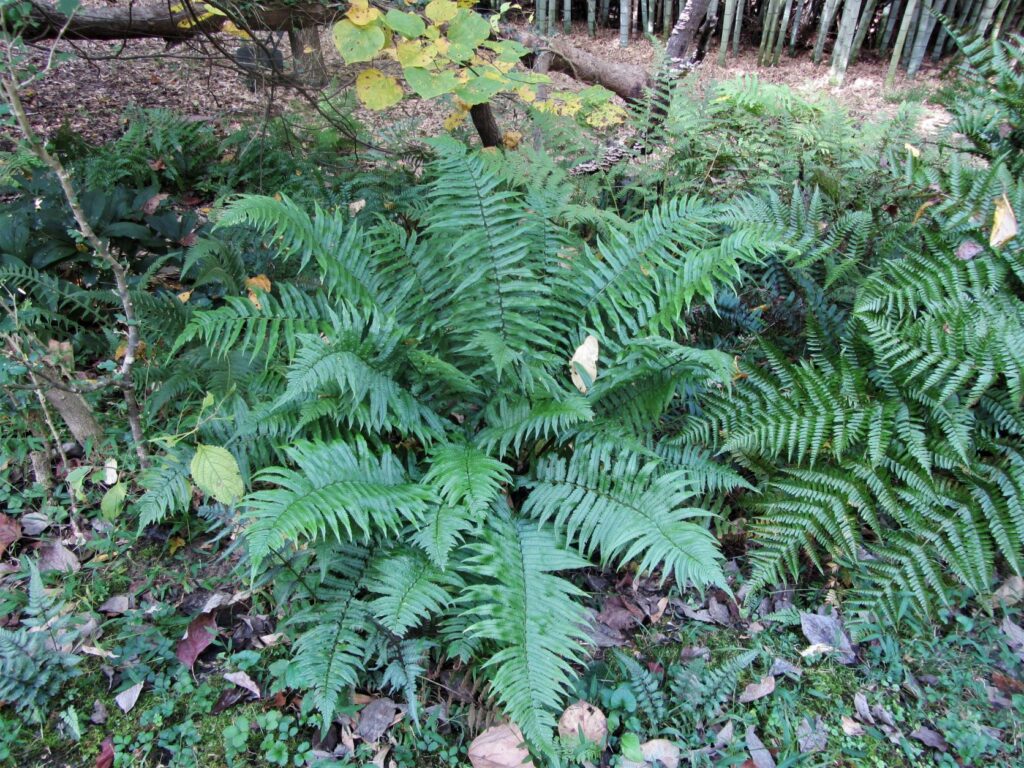
D. x Australis grows to the left of D. erythrosora. Volunteer Athyriums are deciduous and disappear after the first frost, while evergreen ferns maintain their beauty throughout the year.
All Photos by E. L. McCoy
For More Information:
Hallowell, Barbara and Anne C. Hallowell. Fern Finder: A Guide to Native Ferns of Central and Northeastern United States and Eastern Canada. Nature Study Guild Publishers. 2001.
Hoshizaki, Barbara Joe Hoshizaki and Robbin C. Moran. Fern Grower’s Manual: Revised and Expanded Edition. Timber Press. 2001.
Olsen, Sue. The Encyclopedia of Garden Ferns. Timber Press. 2007.
Rickard, Martin. Ferns for a Cool Temperate Climate. The Crowood Press. 2021.
Steffen, Richie and Sue Olsen. The Plant Lover’s Guide to Ferns. Timber Press. 2015
Sources for a Variety of Ferns
Ulster American Homestead Garden Center James City County
Forest Lane Botanicals York County, open seasonally
The Great Big Greenhouse Chesterfield County
McDonald’s Garden Center Hampton Roads, with locations in our area each spring
Plant Delights Nursery (online nursery with limited public hours)
Ferns may be found seasonally at Lowes, Home Depot, and other local vendors

